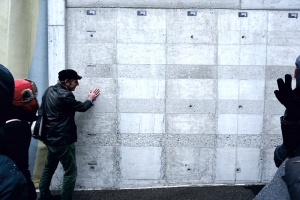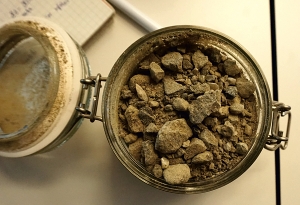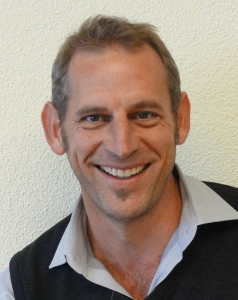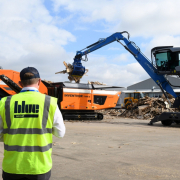The Swiss Example: Using Recycled Concrete
Reaching for the sky with construction and demolition waste recycling: A report, provided by ICLEI – Local Governments for Sustainability (a network of over 1,500 cities, towns and metropolises committed to building a sustainable future), on a study visit in Zurich.
Construction and demolition waste (CDW) is one of the largest waste streams in the European Union (EU). According to the European Commission, 25-30 percent of all waste generated in the EU consists of CDW materials – many of which could be recycled. The question then is if recycled concrete can be used to build houses and what the pros and cons are. To shed light on this matter, the EU-funded project UrbanWINS recently organized a study visit to Zurich, a city that has been using recycled concrete and other construction materials over the last 15 years.
Growing urban areas demand an ever-larger amount of construction material. Concrete is among the most popular, and it is highly flexible, resistant and stable. However, an increase in the demand for concrete translates into a growth of environmental pressures. Conventional concrete production requires gravel and sand as filling materials – they make up to 80 percent of the weight of concrete. Seemingly abundant, they are finite and scarce resources, and their mining and transport degrade the environment. Furthermore, cement is energy and CO2 emission intensive in production.
Instead, the mineral components of CDW can be used to produce new concrete. This type of urban mining for new buildings increases their resource efficiency and makes the construction sector less dependent on scarce resources. This avoids mining and landfilling, and protects precious landscapes and habitats. It can also improve the energy balance of new buildings, especially if materials are recycled and reused locally. It is a step towards closed-loop resource use.
Today cities are keen to learn about this type of innovation to meet the growing demand for housing in urban areas while using resources more efficiently and in an environmentally friendly way. “We just started a project involving recycling concrete,” explained Roni Järvensivu, Environmental Quality and Safety Senior Specialist of Helsinki Region Environmental Services Authority, who joined the UrbanWINS study visit. “We have roughly 500,000 tons of concrete waste, but our company only treats about 20,000 tons, so with this visit we would like to learn about new ways to reuse it.”
The city of Zurich has been a frontrunner in concrete recycling with over 15 years of experience. To showcase this expertise and inspire European public authorities in the field, the City’s Environmental and Health Protection Service hosted a three-day visit for practitioners, as part of the CityMatch activity run by ICLEI Europe, under the umbrella of the UrbanWINS project.
The city is pushing the boundaries of what was thought possible. Newer buildings achieve rates of up to 50 percent recycled components in the concrete. Other countries, such as Finland, still maintain a maximum of ten percent of added non-concrete mineral materials for producing concrete.
The Zurich Art Museum, the Kunsthaus, is currently undergoing a major extension. The new complex designed by architect David Chipperfield is made almost entirely of concrete with recycled aggregates and CEM III/B cement (where conventional clinker is replaced by slag sand), including the indoor space shaped by bare concrete. Recycled materials are also used in Zurich’s road construction and maintenance: In the sub-base (foundation layer) up to 30 percent of recycled concrete is used, and for the road base, up to 60 percent of reclaimed asphalt is permitted and used, or even up to 80 percent on sidewalks and places with low traffic. Tests with a new mixture of reclaimed asphalt look very promising in terms of quality. The amount of reclaimed asphalt may increase in the future.
“Mining urban waste materials for new construction does make sense, but only if these are locally available,” remarked Philipp Noger of Zurich’s Office of Building Construction. “Recycling construction materials is particularly useful in dense urban areas, where a constant stream of construction and demolition waste occurs. Using recycled concrete within near distances is often cheaper than new concrete. In the end,” the architect highlighted, “we also need to design for reuse and recycling, to reduce the overall amount of mixed materials resulting from demolition.”
Attendees of CityMatch were impressed by the possibilities that recycled materials offer. “This three-day visit has been an eye-opener for us on how to use recycled concrete in buildings,” said Roni Järvensivu. Margherita Carè, the architect for the Metropolitan City of Rome Capital, added that their plan is to “go back home and see how we can change our standards for using recycled concrete, taking the Swiss examples as a baseline.”
Despite the advantages, many local governments are not aware of the possibilities to work with CDW as a resource. The European Commission wants to change that. One of the objectives of the Waste Framework Directive (2008/98/EC) is to provide a framework for moving towards a European recycling society with a high level of resource efficiency. It challenges Member States to prepare a minimum of 70 percent of their CDW for reuse, recycling or recovery by 2020.
From demolition to new resource
A precondition to successful reuse of CDW is the sorting of construction materials upon demolition. “It takes years of experience to reach the levels of recycled components in the final product that we have in Zurich right now. We refined our recycling process to the point that recycled mineral aggregates can be used without any impacts on the quality of the construction material,” said Michael Strauss, responsible for quality control of materials from Eberhard Bau AG. The civil engineering and recycling company is a pioneer in providing recycled aggregates for the construction sector. The sorting and recycling process results in gravel that can replace up to 50 percent of natural sand and gravel in concrete production.
Challenges ahead
Recycling CDW for producing new concrete does address resource scarcity, whereas it does not solve the issue of CO2 emissions which results from concrete production. Producing clinker, the key element of concrete requires a production process that causes CO2 emissions. As a result, as much carbon dioxide is released into the atmosphere each year as Europe’s 300 million cars: 1.5 billion tons. Using slag ashes – a leftover product from iron smelting – can improve the CO2 balance of concrete by reducing emissions related to the production process by 25 percent. However, concrete remains a CO2 intense product. For a low- to zero-carbon future, the construction sector will also need to look into other materials.
For more information www.urbanwins.eu / Twitter: @UrbanWINS
_______________________
The UrbanWINS project and its CityMatch activity
Cooperating with the Procura+ European Sustainable Procurement Network, CityMatch is an exchange program for professionals to provide a forum for learning and substitution on waste management and sustainable procurement. The activity is part of UrbanWINS, an EU-funded project that supports eco-innovation in waste prevention and management with the involvement of citizens and pilots actions in eight European cities. For this second edition of the CityMatch, experts from the Metropolitan City of Rome Capital and the Helsinki Region Environmental Services Authority traveled to Zurich to learn about the circular procurement and the reuse of concrete used for buildings (recycled concrete) and road construction (concrete and recycled asphalt).
The UrbanWINS project is now finished. In April this year, the “UrbanWINS Final Conference – The city as a living organism: understanding its metabolism to reduce its resource consumption” took place in Brussels. Partners and stakeholders from all the countries involved and people interested in many different fields came together to share the experiences and outcomes from the three years of intense work and engage in lively and creative workshop sessions.
_______________________
“Reusing Waste as a Resource Is a Chance”
Short Interview with Sonja Gehrig, Project Manager of Sustainable Public Procurement and Cooperation, Environmental and Health Protection Service at the City of Zurich, and Philipp Noger, Architect at the city’s Building Surveyor’s Office.
Why did the City of Zurich decide to start using recycled concrete?
Sonja Gehring: As a city, Zurich has the goal to reduce its impact on the environment as much as possible. Reusing waste as a resource is a chance for us to achieve this goal in a sector that traditionally has a large environmental footprint. In the late 90ies, the city of Zurich started to monitor the amounts of construction and demolition waste and looked for possibilities to put this material to better use. We had already implemented a range of measures to improve waste sorting practices on demolition sites. In cooperation with a local concrete company who developed new technical solutions to reuse concrete and mineral materials, we started to build schools and other public buildings with recycled concrete. Soon other companies followed, and a market emerged. This way, we are able to reduce landfilling and protect scarce natural resources. In the long term, this strategy also saves money for the city of Zurich and brings new opportunities to the companies involved with recycling concrete. A major impact had the construction of the Letzigrund stadium, where time-pressure led to the direct use of recycled excavation materials on site.
What are the main difficulties you have encountered?
Philipp Noger: On the one hand, we had to convince many stakeholders in the construction sector that using recycled materials in concrete is safe and aesthetically appealing. On the other hand, we need to find ways to better reuse mixed mineral aggregates, which consist not of pure concrete, but of a mix of mineral materials. Not for all concrete qualities, concrete from mixed mineral aggregates could be used. The Research and Development departments of our suppliers are busy improving their processes to deal with this issue.
Do you have any law in place to support the use of recycled concrete?
Philipp Noger: Since 2007, the city of Zurich started to promote the use of recycled concrete for new public buildings. And since 2015, the use of CEM III/B (cement containing slag ashes with a reduced carbon impact by -25 percent of CO2) is preferred, wherever possible. One of the major Swiss certification systems for ecological buildings (Minergie-ECO) now requires the use of recycled concrete. These developments and the administration of Zurich’s general demand for recycled concrete have caused an overall spike in demand to which the market has responded by producing more and more recycled construction materials. This showed us that supply follows demand, and policymakers can push the market towards higher recycling rates.
Are you planning to use any other recycled materials in the future?
Philipp Noger: Aside from increasing the share of recycled materials in new concrete and asphalt, we are currently looking into recycling insulation materials. This is not yet done at a large scale, but we see – especially concerning insulation materials – an upcoming necessity to reduce our material consumption and waste production by closing this material loop as well. Also in terms of asphalt, tests with a new mixture of reclaimed asphalt are very promising that the previous difference of quality could be eliminated at a share of recycling materials of 60 percent or more in the road base. The amount of reclaimed asphalt may be increased in the future.
Photo: ICLEI
Author: Paula Land, Officer, Sustainable Economy and Procurement, ICLEI – Local Governments for Sustainability
(GR 22019, Page 30)











